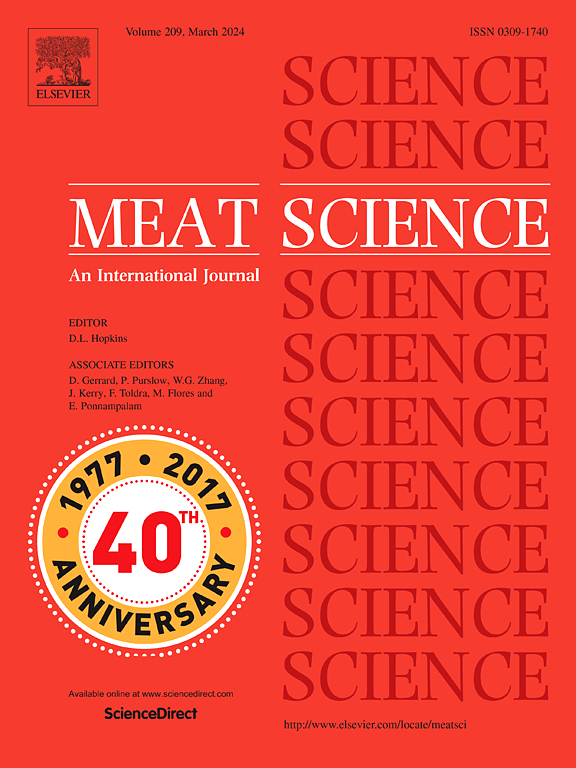评估膳食中添加荠菜(L. Crantz)对生长兔肉质和感官特征的影响
IF 6.1
1区 农林科学
Q1 Agricultural and Biological Sciences
引用次数: 0
摘要
本研究调查了日粮中添加荠菜油籽饼对生长兔肉质和感官特征的影响。研究人员将 168 只 32 日龄杂交家兔(雌雄兼用)随机分配到三个实验组:对照组(10% 油菜籽饼作为主要粗蛋白来源)、CS5 组(5% 油菜籽饼和 5% CSC)和 CS10 组(10% CSC)。屠宰(74 日龄)后,剖开腰长肌(LL)和后腿(HL),对其肉质进行物理性状(LL 和股二头肌;BF)、感官属性(LL)、近似物成分和脂肪酸(FA)概况(整个 HL)的评估。加入 CSC 对肉质的物理性状没有明显影响,除了黄度,BF 和 LL 肌肉的黄度都有所下降(P < 0.05)。肉的含水量随 CSC 的加入呈线性下降(P < 0.05)。饲喂含 CSC 日粮的家兔 HL 肉的脂肪酸谱发生了变化:饱和脂肪酸(P < 0.001)和单不饱和脂肪酸(P < 0.001)减少,多不饱和脂肪酸(P < 0.001)增加。欧米茄-3 脂肪酸含量随着 CSC 含量的增加而线性增加(P < 0.001),n-6/n-3 比率也随之降低(与对照组相比,CS10 的比率降低了一半;P < 0.001)。CS10 处理的脂肪味、酸败味、异常风味强度和总体风味强度最高。然而,总体接受度并未受到影响。这些研究结果表明,CSC 可以作为一种可行的蛋白质来源,用于可持续的兔肉生产,并为消费者提供健康的肉类。本文章由计算机程序翻译,如有差异,请以英文原文为准。
Assessing the impact of dietary Camelina sativa (L.) Crantz inclusion on meat quality and sensory traits of growing rabbits
This study investigated the effects of dietary Camelina sativa oilseed cake (CSC) inclusion on the meat quality and sensory traits of growing rabbits. A total of 168 crossbred 32-day-old rabbits (both sexes) were randomly allocated into three experimental groups: a Control diet (10 % rapeseed oilseed cake as main crude protein source), CS5 diet (5 % rapeseed oilseed cake and 5 % CSC), and CS10 diet (10 % CSC). After slaughter (74 days of age), longissimus lumborum (LL) muscles and hind legs (HL) were dissected and their meat were evaluated for physical traits (LL and biceps femoris; BF), sensory attributes (LL), proximate composition and fatty acid (FA) profile (whole HL). The CSC inclusion did not significantly affect physical meat traits, except for yellowness, which decreased (P < 0.05) in both BF and LL muscles. Meat water content decreased linearly with CSC inclusion (P < 0.05). The FA profile of the HL meat was modified in rabbits fed CSC-containing diet: decreased saturated FA (P < 0.001) and monounsaturated FA (P < 0.001) and increased polyunsaturated FA (P < 0.001). Omega-3 FA content linearly increased with the CSC inclusion level (P < 0.001) and, consequently, the n-6/n-3 ratio decreased (halved ratio in CS10 compared to Control; P < 0.001). The CS10 treatment had the highest fatty flavour, rancid flavour, abnormal flavour intensity, and overall flavour intensity. However, overall acceptance was not affected. These findings suggest that CSC can be a viable protein source for sustainable rabbit production and healthy meat for consumers.
求助全文
通过发布文献求助,成功后即可免费获取论文全文。
去求助
来源期刊

Meat Science
工程技术-食品科技
CiteScore
12.60
自引率
9.90%
发文量
282
审稿时长
60 days
期刊介绍:
The aim of Meat Science is to serve as a suitable platform for the dissemination of interdisciplinary and international knowledge on all factors influencing the properties of meat. While the journal primarily focuses on the flesh of mammals, contributions related to poultry will be considered if they enhance the overall understanding of the relationship between muscle nature and meat quality post mortem. Additionally, papers on large birds (e.g., emus, ostriches) as well as wild-captured mammals and crocodiles will be welcomed.
 求助内容:
求助内容: 应助结果提醒方式:
应助结果提醒方式:


